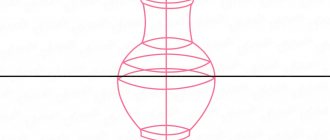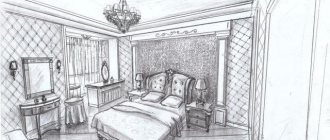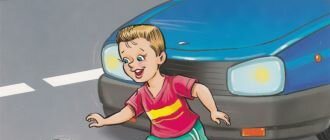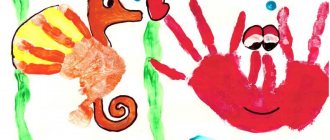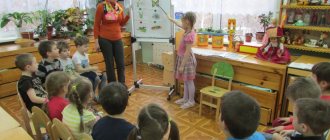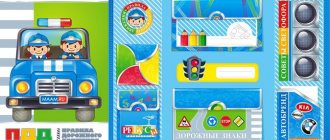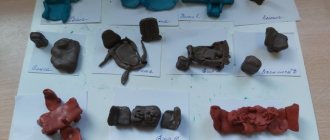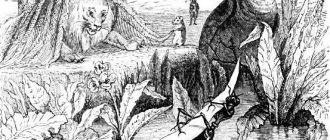"Furniture" GCD in the second junior group
Performed:
Ivanova Elena Yurievna,
teacher
MADOOU Borovsky kindergarten "Zhuravushka"
GCD summary: “Development of mathematical abilities by means of non-traditional drawing in the second junior group on the topic “Furniture”
Goal: To develop children's powers of observation, elementary mathematical concepts, and holistic visual perception of the world around them.
Tasks:
1. Develop the ability to navigate in spatial directions (draw lines from top to bottom, left to right, use the words “on”, “in”, “behind”);
2. Develop the ability to see the general characteristics of objects (shape, color, size, material of manufacture), use the general concept of “furniture”;
3. Continue learning to draw straight lines.
GCD move:
During free play activities, children find a broken doll chair and table.
Children: - Elena Yuryevna!
Educator: - What happened, guys?
Children: - The furniture for the dolls is broken!
Educator: - What a pity... But we can help the dolls! And I know how! Where do you think furniture is made?
— Children's answers (at the factory)
Educator: - Correct!
Educator: - Guys, let's help our toys. I propose to open a furniture factory here. Close your eyes, turn around yourself - one, two, three! We became carpenters!
What pieces of furniture do you know? (children's answers). Bed, chair, table, wardrobe.
What do they sleep on? (on the bed).
Where do clothes go? (into the cupboard).
What are they sitting on? (on the chair)
What do they have lunch for? (At the table)
What is furniture made of? (from boards).
On the table for each child are prepared sheets of dots, as well as gouache and cotton swabs.
In front of the children there is a children's table and chair
Educator: What is there at the table?
Children: Legs and table top. They show.
Educator: What does the chair have?
Children: Seat, back and legs?
Educator: What do a table and a chair have in common?
Children: There are 4 legs, the seat and table top are square, and the table and chair are made of wood.
Educator: To make furniture, you need special drawings, which are called “schemes”. Can you draw? (yes) Then let's try to draw diagrams of a table and a chair...
Before us lie really smooth boards and drawings - mysterious drawings.
Educator: If you look at them carefully, you will see what it looks like: a table or a chair. what should be done?
The dots will help you read the drawing, open the drawing. Try to connect these points with a line (I show you how to do this on the sheet). The guys begin to draw and connect the lines of their drawings.
At the end of the GCD we consider what tables and chairs we got.
Cheerful music plays, the teacher and the children conduct the dance game “We are sitting on chairs.”
Educator: - What wonderful masters you are! Now we can send these drawings of chairs and tables to a furniture factory. And they will make us new furniture for the dolls! And then they will deliver it for our dolls! (put the drawings in a large envelope to send them)
Used Books
- From birth to school. Basic educational program of preschool education / ed. NOT. Veraksy, T.S. Komarova, M.A. Vasilyeva. – 4th ed., revised. – M.: MOSAIKA-SYNTHESIS, 2022. – 352 pp.;
- Approximate comprehensive thematic planning for the program “From birth to school.” Second junior group / Ed. T.S. Komarova. - .: MOSAIC-SYNTHESIS, 2022. – 168 pp.;
- Complex classes according to the program “From birth to school” edited by M.A. Vasilyeva, V.V. Gerbova, T.S. Komarova. Second junior group / author-comp. T.V. Kovrigina, M.V. Kosyanenko, O.V. Pavlova. – Volgograd: Teacher, 2013. – 262 p.;
- https://www.maam.ru/detskijsad/konspekt-zanjatija-po-poznavatelnomu-razvitiyu-vo-vtoroi-mladshei-grupe-na-temu-mebel.html
“Certificate of publication in the media” Series A No. 0007630
We invite teachers of preschool education in the Tyumen region, Yamal-Nenets Autonomous Okrug and Khanty-Mansi Autonomous Okrug-Yugra to publish their teaching materials: - Pedagogical experience, original programs, teaching aids, presentations for classes, electronic games; — Personally developed notes and scenarios of educational activities, projects, master classes (including videos), forms of work with families and teachers.
Why is it profitable to publish with us?
1. “Kindergartens of the Tyumen Region” is an officially registered specialized media outlet at the federal level. 2. The activities of the editorial office are supported by the Department of Education and Science of the Tyumen Region 3. We issue a “Certificate of Publication” in the media. 4. The document has a unique number, is entered in the register, has the original seal of the editorial office of the online publication and signature. 5. “Certificate of publication” in the media is sent to the author in both paper and electronic versions.
Details >>>
Sample “Certificate of publication of author’s methodological material in the media.”pdf
Share
Preview:
Fine arts activities for children of the younger group.
Topic: “Furniture for Masha”
Goal: to consolidate ideas about furniture, its types and purpose;
- strengthen the ability to work with a brush;
- strengthen the ability to follow adult instructions;
- cultivate accuracy and independence in work.
Materials: illustrations depicting pieces of furniture, gouache in different colors.
Educator: Guys, today I met a girl Masha from a fairy tale. She was very upset and even cried. She was hurt by bears. What fairy tale do you think this girl is from?
Children: Fairy tale "Masha and the Bears"
Educator: Correct. What happened in the fairy tale?
Educator: I want to know what pieces of furniture you know? Let's solve the riddles.
It stands in every bedroom, and clothes lie in it. He is stately and majestic, Let’s say together - this is... (wardrobe)
The day has passed, it’s time to sleep, I’ll spread out my...(bed)
Even though I have four legs, I can’t run along the path. After all, when lunch came, everyone sat down at... (kitchen table)
Faithful friends of our table, Although they stand, they sit on them. (Chairs)
Educator: Correct. Let's help Mashenka and draw a table and chair for her so that she can have lunch. All that remains is to choose the color you will paint with.
As the teacher shows, the children draw. The images are schematic, made from lines.
Educator: Well done, guys, you are real masters. Masha is very happy, because now she has beautiful furniture.
Source
Read also
Topic of the week: “My Home”
Theme of the week “My Home” Lesson 22. House for a bunny and a rooster (Plasticine modeling) Program content. Strengthen children's ability to bring a product to the desired image using plasticine. Learn to retell fairy tales based on illustrations. Demonstration material. Heroes
Theme of the week: “Furniture”
Topic of the week: “Furniture” Lesson 11. Table and chair (Plasticine molding) Program content. Learn to cut elongated plasticine columns into pieces using a stack and attach them to cardboard, depicting pieces of furniture in the form of a bas-relief (the image protrudes above
Topic of the week: “My Home”
Topic of the week: “My Home” Lesson 41–42. Houses of the Three Little Pigs (part 1–2) (Drawing with pastel crayons, sanguine, charcoal, wax crayons) Program content. Continue learning how to make illustrations for fairy tales. Develop the ability to arrange objects on a sheet of paper. Learn
Theme of the week: “Furniture”
Topic of the week: “Furniture” Lesson 11. Blanket for Vanyushka (Drawing with felt-tip pens) Program content. Teach children to decorate a rectangular object with colored stripes, alternating them by color. Learn to understand and analyze the content of the nursery rhyme. Cultivate benevolence
Topic of the week: “My Home”
Theme of the week “My Home” Lesson 21. Houses for nesting dolls (Drawing with colored pencils) Program content. Teach children to draw small and large objects consisting of a square and a triangle. Continue learning how to compose a plot composition. Cultivate responsive
Topic of the week: “In the kitchen”
Theme of the week “In the kitchen” Lesson 17. Gzhel cup (Painting with gouache) Program content. Introduce children to Gzhel. Learn to highlight the characteristic features of Gzhel painting, decorate the border of a cup with simple elements of painting (straight and wavy lines of various
Topic of the week: “In the room”
Theme of the week “In the room” Lesson 19. Carpet (Decorative drawing with felt-tip pens) Program content. Learn to draw patterns on the carpet in the form of long, non-touching lines. To develop children's aesthetic perception, fantasy and imagination. Cultivate love for Russians
Theme of the week: “Professions”
Theme of the week “Professions” Lesson 23. Color spectrum (Drawing with gouache) Program content. Form an idea of how you can get orange, green, purple and brown colors. Learn to mix basic paints and create new colors. Actively
Theme of the week: “Zoo”
Topic of the week: “Zoo” Lesson 25. Elephant (Palm drawing) Program content. Continue to introduce the technique of palm printing: dip your entire palm in gouache and make an imprint. Develop imagination, teach to see a new image in a familiar object. Strengthen the skill
Theme of the week: “Theater”
Theme of the week “Theater” Lesson 27. Three bears (Drawing with sanguine) Program content. Continue to introduce children to sanguine. Learn to draw sanguine in chalk and shade lines. Continue practicing graphically depicting animals standing on their hind legs. Fasten
Topic of the week: “My Home”
Theme of the week “My Home” Lesson 41. Ice hut (Drawing with pastel crayons) Program content. Continue to introduce children to cool tones. Learn to convey the characteristic features of objects using cool colors. Introduce opportunities
Theme of the week: “Furniture”
Topic of the week: “Furniture” Lesson 10. Rug for rabbits (Brush painting. Watercolors) Purpose. Teach children to decorate a rectangular object, alternating circles and lines (using a brush and watercolors); consistently use paints of two colors;
Topic of the week: “My Home”
Topic of the week: “My Home” Lesson 22. Fence near the house (Brush painting. Gouache) Purpose. Continue to teach children to draw various objects consisting of combinations of lines. Learn to retell fairy tales based on illustrations in the book. Develop speech and thinking. Demonstration
Topic of the week: “My Home”
Topic of the week: “My Home” Lesson 21. Building a house (Modeling from plasticine) Program content. To develop in children the ability to sculpt a house from rolled up columns, placing them on top of each other and firmly connecting them together. Strengthen the ability to use a stack. Develop
Theme of the week: “Furniture”
Topic of the week: “Furniture” Lesson 10. Blanket (Colored paper. Decorative applique) Program content. Continue learning how to apply glue to parts and stick them on a sheet of paper. Learn to make a pattern of circles on a square sheet of paper, alternating them by color. Learn
Topic of the week: “My Home”
Theme of the week “My Home” Lesson 22. House for a bunny and a rooster (Colored paper. Application from prepared parts of an object) Program content. Cultivate compassion and kindness. Teach children to form a whole from several parts; apply glue to the part and stick it
Source
Summary of educational activities for drawing with young children on the topic “Furniture. High chair"
Daria Avdyukhina
Summary of educational activities for drawing with young children on the topic “Furniture. High chair"
Abstract of GCD on artistic and aesthetic development ( drawing )
with
young children on the topic : “
Furniture . Chair » Goals: To develop the skill of holding a pencil in your hand correctly, to draw vertical and horizontal lines, to control the length of the line, its beginning and end, to develop an interest in drawing .
Materials: Pencils/ felt-tip pens, sheets of paper for drawing in A4 format (according to the number of children, a dummy chair , a sample of the finished drawing (Fig. 2)
Teaching methods: Drawing in the air , finishing details
Theme of the week: “Furniture”
Theme of the week: “Furniture”
Lesson 10. Rug for bunnies
(Brush painting. Watercolor paints)
Target. Teach children to decorate a rectangular object, alternating circles and lines (using a brush and watercolors); consistently use paints of two colors; independently come up with a pattern and place it over the entire surface of the object. Cultivate compassion and kindness.
Handout. A rectangular rug cut from light-colored colored paper, watercolor paints, a brush, a jar of water.
Read V. Berestov’s poem “Bunny” to the children:
Because they are small.
Ask the guys: “What did the bunnies want to do? (Bainki, go to sleep.) Where can I put the bunnies?” (In a box, on a chair, on a rug, etc.)
Place a rectangular rug cut out of light colored paper in front of each child and ask: “How can you decorate such a rug?” (Draw circles, triangles, lines, etc.)
Invite the kids to make beautiful rugs for the bunnies, decorating them with alternating multi-colored circles and lines.
At the end of the lesson, ask each child: “What kind of rug did you make? (Beautiful, elegant, colorful, affectionate, etc.) Do you think it will be nice for bunnies to sleep on such a rug?”
This text is an introductory fragment.
Continuation on liters
